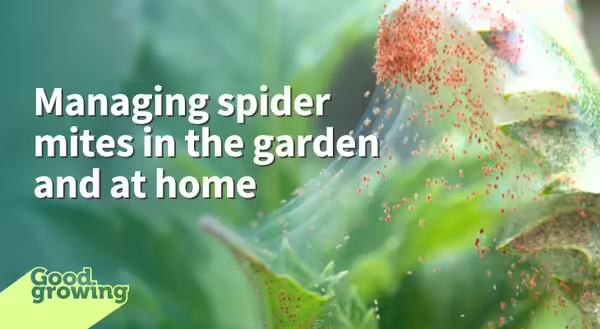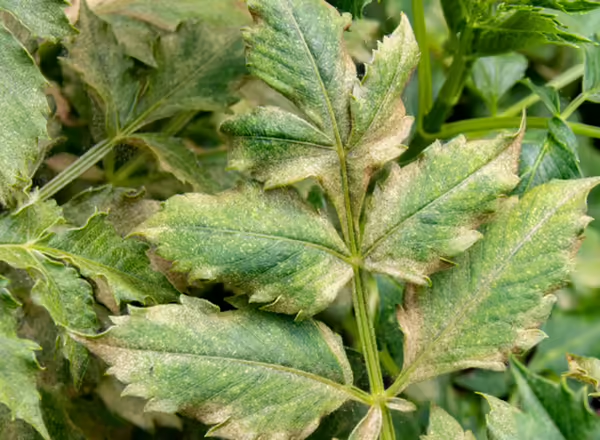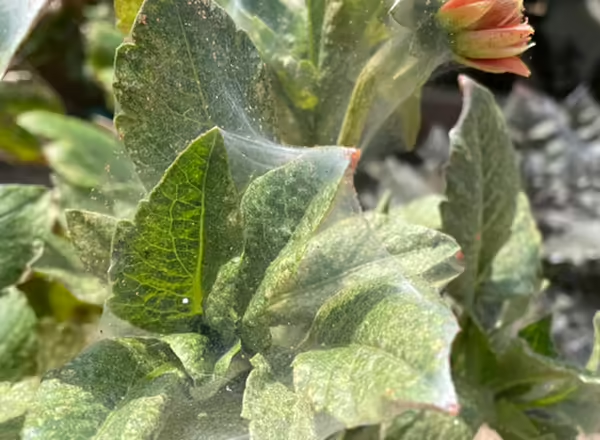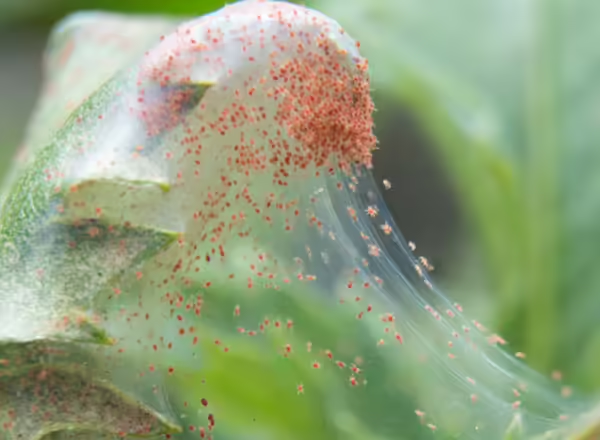
Spider mites are a common pest on many types of plants. The most commonly encountered species is the twospotted spider mite (Tetranychus urticae). While we often think of them attacking houseplants, particularly during the winter months, they can also be a problem on fruits, vegetables, and landscape plants, particularly during hot, dry weather.
What do they look like?
Twospotted spider mites are small (1/50 inch) and oval-shaped. They can range in color from yellowish or greenish (most common) to brown to orange-red, with two dark spots on either side of their body. Because of their small size, they often go unnoticed until plants have significant damage.

They overwinter as adult females on host plants or in the soil. When temperatures begin to warm in the spring (April and May), they will become active and start feeding. Females don't have to mate before reproducing and can lay over 200 eggs in their lifetime. Twospotted spider mites can go from egg to adult in as little as five days during favorable conditions (hot, dry weather), meaning populations can rapidly expand.

Spider mites have sucking mouthparts that they will use to puncture plant material to feed on individual plant cells. They will remove the cell's contents, including chlorophyll, which gives leaves their green color. This causes leaves to have a speckled or mottled appearance. As feeding continues, leaves may begin to yellow or bronze and eventually die. Severe infestations of spider mites can cause plants to become stunted, defoliated, and potentially die.
They also produce webbing, thus their name, which can also indicate their presence. The webbing is produced by glands near their mouths, and strands will be spun on the undersides of infested leaves. As mite populations grow, the webbing can completely cover a plant's leaves, stems, and flowers.
The mites will lay their eggs on the webbing and use it to move around the plant and spread to nearby plants. Additionally, mites can use silk to travel long distances via wind. The webbing can also help protect them from predators and pesticide sprays.

While two-spotted spider mites may not be a problem every year outdoors, they can become a problem during hot, dry weather like we have experienced this year in many parts of central Illinois. Spider mites can be difficult to see until populations get large and plants start showing symptoms of their feeding. If you suspect you have spider mites, closely inspect the undersides of leaves using a magnifying glass.
Alternatively, you can use a piece of white paper and shake plant leaves over it. This will cause any mites present to fall on the paper, making them easier to see. It's important to note that not all mites are pests; some are predators of other mites. One way to determine if you have a pest or predatory species is to crush and smear them. For the most part, mites that feed on plants (pests) will be green, while predatory species will be yellow or orange.
There are several things you can do to manage spider mites:
- Twospotted spider mites thrive during hot, dry weather and on stressed plants. Making sure plants are well watered during these conditions can go a long way in preventing outbreaks.
- Spider mites are often introduced into landscapes and homes on infested plant material. Inspect plants before putting them in your landscape or bringing them indoors. Plants can also be quarantined away from other plants until you are sure no spider mites are present.
- Spray infested plants with a forceful spray of water. This will remove the mites, their eggs, and webbing. You may need to repeat this several times.
- Predators such as lacewings, lady beetles, and predatory mites will often keep spider mite populations in check outdoors. Predatory mites can be purchased and released on infested plants, but they can be expensive and often don't work well indoors. Take steps to conserve predators by providing habitat and avoiding pesticide use if possible.
- Insecticidal soaps and horticultural oils are commonly used to manage spider mites. These pesticides have no residual activity and must come into contact with the mites to work. Therefore, good coverage is important for both the upper and lower sides of leaves when using them.
Good Growing Fact of the Week: Despite often being lumped in with insects, mites are actually arachnids, along with spiders, ticks, and daddy longlegs/harvestmen. Like other arachnids, mites have eight legs and two main body parts compared to insects, with six legs and three main body parts. Additionally, mites do not have antennae or wings.
Signup for our emails! Want to get notified when new Good Growing posts are available? SIGN ME UP
MEET THE AUTHOR
Ken Johnson is a Horticulture Educator with University of Illinois Extension, serving Calhoun, Cass, Greene, Morgan, and Scott counties since 2013. Ken provides horticulture programming with an emphasis on fruit and vegetable production, pest management, and beneficial insects. Through his programming, he aims to increase backyard food production and foster a greater appreciation of insects.